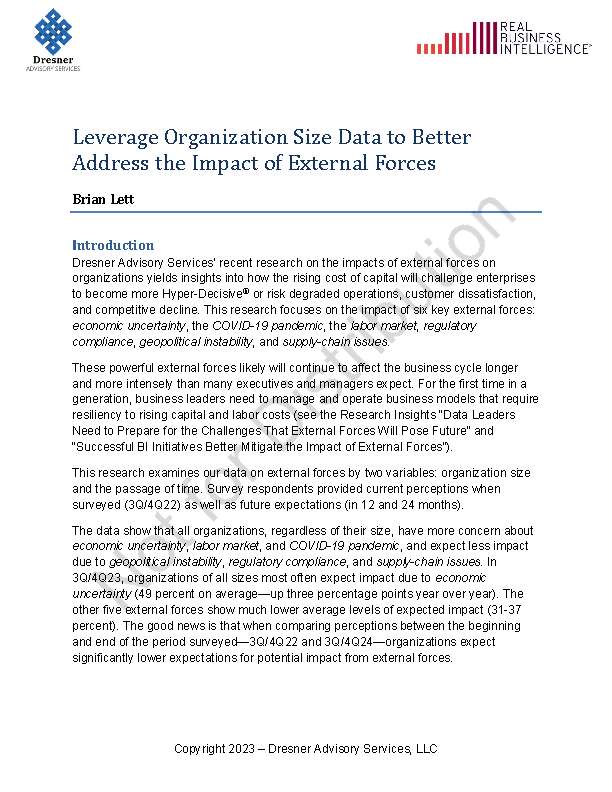
This research examines our data on external forces by two variables: organization size and the passage of time. Survey respondents provided current perceptions when surveyed (3Q/4Q22) as well as future expectations (in 12 and 24 months).
The data show that all organizations, regardless of their size, have more concern about economic uncertainty, labor market, and COVID-19 pandemic, and expect less impact due to geopolitical instability, regulatory compliance, and supply-chain issues. In 3Q/4Q23, organizations of all sizes most often expect impact due to economic uncertainty (49 percent on average—up three percentage points year over year). The other five external forces show much lower average levels of expected impact (31-37 percent). The good news is that when comparing perceptions between the beginning and end of the period surveyed—3Q/4Q22 and 3Q/4Q24—organizations expect significantly lower expectations for potential impact from external forces.
Organization size is not something one can readily change or affect. Size changes usually tend to be gradual and achieved through organic growth. Although mergers and acquisitions can provide the ability to transform an organization’s size quickly, these activities require a significant amount of time for negotiations, due diligence, consummation and, ultimately, integration. In reverse, divestitures can break up a larger organization into numerous smaller ones—but still need a lot of time to complete. Even a combination of growth and acquisitions needs time to expand an organization from one size to another. In short, organization size is a current-state attribute, not a lever at executive management’s disposal to adjust business operations to respond to things like impacts from external forces.
Rather than “wish” they could gain or have the attributes of a competitor of a different size, organizations instead should look to use our data on organization size to inform how they might better address the impact of external forces. For example, speed and flexibility tend to provide competitive differentiation to the smallest organizations. Our data show that the smallest organizations by far expect the least incidents of impact from supply-chain issues. A much larger organization struggling with supply-chain issues might use this insight to look for ways to “inject” speed and flexibility into addressing this challenge—for example, streamlining or accelerating their processes associated with qualification of new suppliers and company-preferred vendors.
External forces provide data leaders with a clear call to improve data sources and quality, and invest in advanced analytics. But data leaders should not lead this C-level discussion with BI. Instead, they should start the conversation by showing how data and analytics approaches, competencies, literacy, processes, tools, management, and governance supports specific business objectives and enables achievement of specific business outcomes.
You do not have permission to access this document. Make sure you are logged in and/or please contact Danielle with further questions.